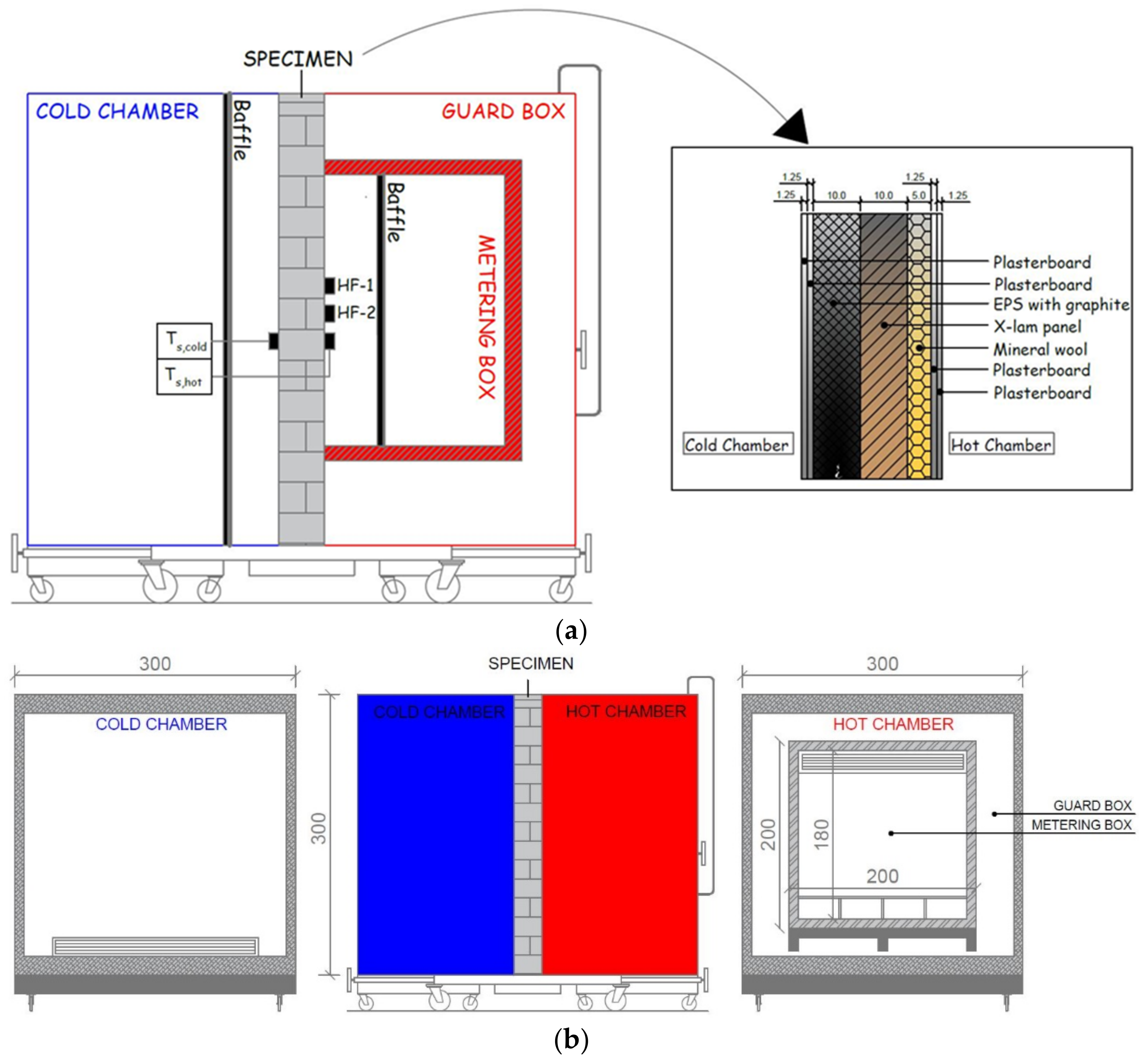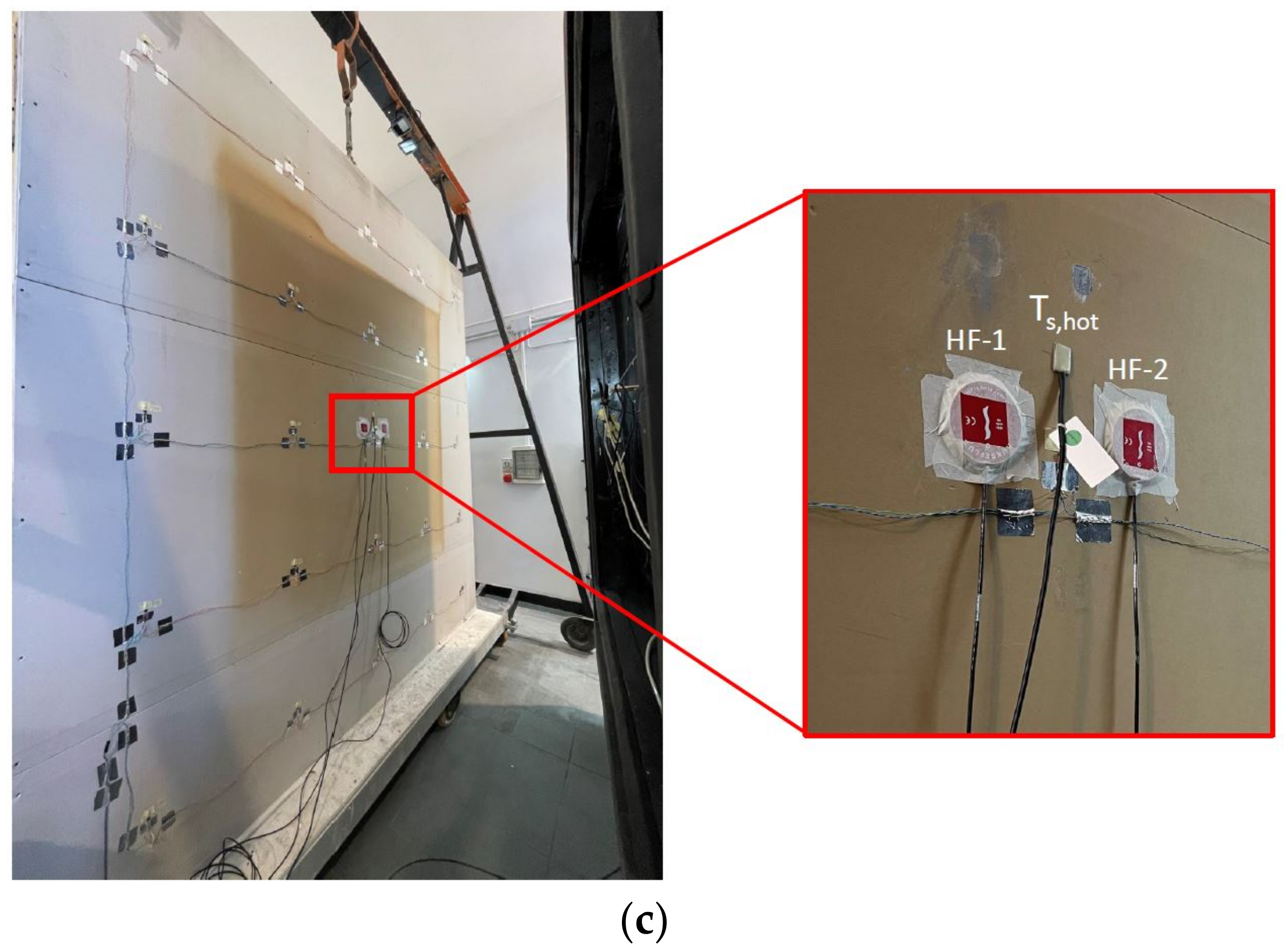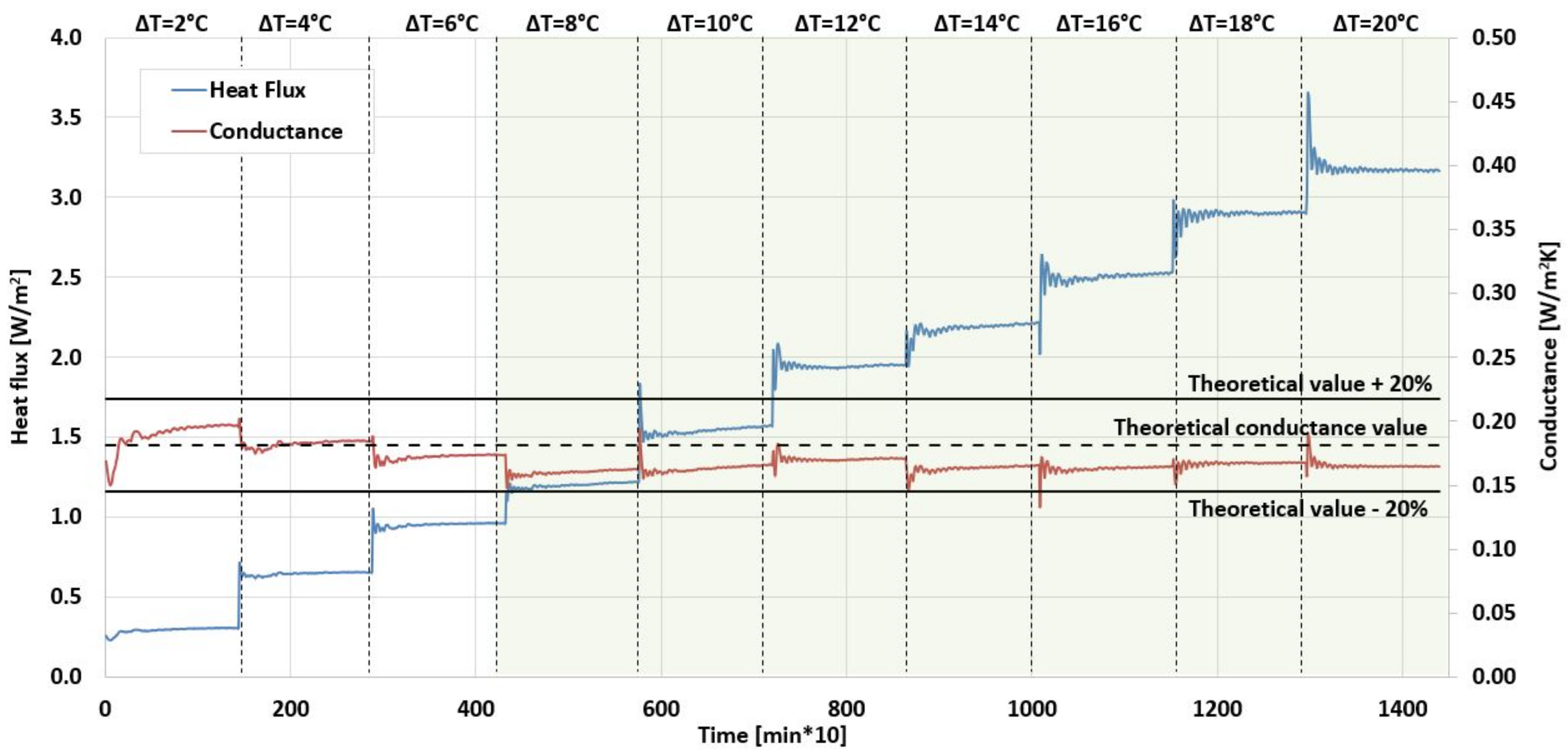How Do Temperature Differences and Stable Thermal Conditions Affect the Heat Flux Meter (HFM) Measurements of Walls? Laboratory Experimental Analysis
Abstract
:1. Introduction
2. Materials and Methods
2.1. Theoretical Background
2.2. Experimental Tests via Guarded Hot Box
2.3. In Situ Thermal Transmittance Measurements
2.4. Methodology
2.5. Limitations
- tests should also be performed on different walls than the one used;
- the steps of temperature differences variation could be reduced to values less than 2 °C;
- enhanced experimental setup could be used to understand the effects of surface heat transfer coefficients;
- in situ experimental analyses should be conducted to understand how to mitigate less stable thermal conditions due to varying boundary conditions.
3. Results and Discussion
4. Conclusions
Author Contributions
Funding
Institutional Review Board Statement
Informed Consent Statement
Data Availability Statement
Conflicts of Interest
Nomenclature
| C [W/m2K] | Thermal conductance |
| CHB | Calibrated hot box |
| GHB | Guarded hot box |
| HFM | Heat-flow meter method |
| i [W/mK] | Thermal conductivity |
| q [W/m2] | Heat flux rate |
| Rcond [m2K/W] | Conduction thermal resistance |
| Rse [m2K/W] | Outer surface thermal resistance |
| Rsi [m2K/W] | Inner surface thermal resistance |
| Rtot [m2K/W] | Total thermal resistance |
| si [m] | Thickness |
| Te [°C] | External air temperature |
| Ti [°C] | Internal air temperature |
| Tse [°C] | Outer wall surface temperature |
| Tsi [°C] | Inner wall surface temperature |
| U [W/m2K] | Thermal transmittance |
| w | Uncertainty |
| xi | Independent variable |
| z | Function of independent variables |
References
- Jones, G.F.; Jones, R.W. Steady-state heat transfer in an insulated reinforced concrete wall: Theory, numerical simulations, and experiments. Energy Build. 1999, 29, 293–305. [Google Scholar] [CrossRef]
- Haralambopoulos, D.A.; Paparsenos, G.F. Assessing the thermal insulation of old buildings—The need for in situ spot measurements of thermal resistance and planar infrared thermography. Energy Convers. Manag. 1998, 39, 65–79. [Google Scholar] [CrossRef]
- Nardi, I.; Perilli, S.; de Rubeis, T.; Sfarra, S.; Ambrosini, D. Influence of insulation defects on the thermal performance of walls. An experimental and numerical investigation. J. Build. Eng. 2019, 21, 355–365. [Google Scholar] [CrossRef] [Green Version]
- Nardi, I.; de Rubeis, T.; Buzzi, E.; Sfarra, S.; Ambrosini, D.; Paoletti, D. Modeling and optimization of the thermal performance of a wood-cement block in a low-energy house construction. Energies 2016, 9, 677. [Google Scholar] [CrossRef] [Green Version]
- Vereecken, E.; Roles, S. A comparison of the hygric performance of interior insulation systems: A hot box-cold box experiment. Energy Build. 2014, 80, 37–44. [Google Scholar] [CrossRef]
- Woltman, G.; Noel, M.; Fam, A. Experimental and numerical investigations of thermal properties of insulated concrete sandwich panels with fiberglass shear connectors. Energy Build. 2017, 145, 22–31. [Google Scholar] [CrossRef]
- Gao, Y.; Roux, J.J.; Teodosiu, C.; Zhao, L.H. Reduced linear state model of hollow blocks walls, validation using hot box measurements. Energy Build. 2004, 36, 1107–1115. [Google Scholar] [CrossRef]
- Luo, C.; Moghtaderi, B.; Hands, S.; Page, A. Determining the thermal capacitance, conductivity and the convective heat transfer coefficient of a brick wall by annually monitored temperatures and total heat fluxes. Energy Build. 2011, 43, 379–385. [Google Scholar] [CrossRef]
- Maier, M.; Salazar, B.; Unluer, C.; Taylor, H.K.; Ostertag, C.P. Thermal and mechanical performance of a novel 3D printed macro-encapsulation method for phase change materials. J. Build. Eng. 2021, 43, 103124. [Google Scholar] [CrossRef]
- de Rubeis, T. 3D-printed blocks: Thermal performance analysis and opportunities for insulating materials. Sustainability 2022, 14, 1077. [Google Scholar] [CrossRef]
- Desogus, G.; Mura, S.; Ricciu, R. Comparing different approaches to in situ measurement of building components thermal resistance. Energy Build. 2011, 43, 2613–2620. [Google Scholar] [CrossRef]
- Wang, F.; Wang, D.; Wang, X.; Yao, J. A data analysis method for detecting wall thermal resistance considering wind velocity in situ. Energy Build. 2010, 42, 1647–1653. [Google Scholar] [CrossRef]
- Ficco, G.; Iannetta, F.; Ianniello, E.; Alfano, F.R.D.; Dell’Isola, M. U-value in situ measurement for energy diagnosis of existing buildings. Energy Build. 2015, 104, 108–121. [Google Scholar] [CrossRef]
- Meng, X.; Yan, B.; Gao, Y.; Wang, J.; Zhang, W.; Long, E. Factors affecting the in situ measurement accuracy of the wall heat transfer coefficient using the heat flow meter method. Energy Build. 2015, 86, 754–765. [Google Scholar] [CrossRef]
- Cucumo, M.; Ferraro, V.; Kaliakatsos, D.; Mele, M. On the distortion of thermal flux and of surface temperature induced by heat flux sensors positioned on the inner surface of buildings. Energy Build. 2018, 158, 677–683. [Google Scholar] [CrossRef]
- Guattari, C.; Evangelisti, L.; Gori, P.; Asdrubali, F. Influence of internal heat sources on thermal resistance evaluation through the heat flow meter method. Energy Build. 2017, 135, 187–200. [Google Scholar] [CrossRef]
- Gaspar, K.; Casals, M.; Gangolells, M. Influence of HFM thermal contact on the accuracy of in situ measurements of façades’ U-value in operational stage. Appl. Sci. 2021, 11, 979. [Google Scholar] [CrossRef]
- Evangelisti, L.; Guattari, C.; Asdrubali, F. Comparison between heat-flow meter and Air-Surface Temperature Ratio techniques for assembled panels thermal characterization. Energy Build. 2019, 203, 109441. [Google Scholar] [CrossRef]
- Ahmad, A.; Maslehuddin, M.; Al-Hadhrami, L.M. In situ measurement of thermal transmittance and thermal resistance of hollow reinforced precast concrete walls. Energy Build. 2014, 84, 132–141. [Google Scholar] [CrossRef]
- Litti, G.; Khoshdel, S.; Audenaert, A.; Braet, J. Hygrothermal performance evaluation of traditional brick masonry in historic buildings. Energy Build. 2015, 105, 393–411. [Google Scholar] [CrossRef]
- de Rubeis, T.; Evangelisti, L.; Guattari, G.; De Berardinis, P.; Asdrubali, F.; Ambrosini, D. On the influence of environmental boundary conditions on surface thermal resistance of walls: Experimental evaluation through a Guarded Hot Box. Case Stud. Therm. Eng. 2022, 34, 101915. [Google Scholar] [CrossRef]
- Evangelisti, L.; Guattari, C.; Asdrubali, F. Influence of heating systems on thermal transmittance evaluations: Simulations, experimental measurements and data post-processing. Energy Build. 2018, 168, 180–190. [Google Scholar] [CrossRef]
- Bienvenido-Huertas, D. Assessing the environmental impact of thermal transmittance tests performed in façades of existing buildings: The case of Spain. Sustainability 2020, 12, 6247. [Google Scholar] [CrossRef]
- Albatici, R.; Tonelli, A.M. Infrared thermovision technique for the assessment of thermal transmittance value of opaque building elements on site. Energy Build. 2010, 42, 2177–2183. [Google Scholar] [CrossRef]
- Gori, V.; Elwell, C. Estimation of thermophysical properties from in-situ measurements in all seasons: Quantifying and reducing errors using dynamic grey-box methods. Energy Build. 2018, 167, 290–300. [Google Scholar] [CrossRef]
- Genova, E.; Fatta, G. The thermal performances of historic masonry: In-situ measurements of thermal conductance on calcarenite stone walls in Palermo. Energy Build. 2018, 168, 363–373. [Google Scholar] [CrossRef]
- Peng, C.H.; Wu, Z.H. In situ measuring and evaluating the thermal resistance of building construction. Energy Build. 2008, 40, 2076–2082. [Google Scholar] [CrossRef]
- Cesaratto, P.G.; De Carli, M. A measuring campaign of thermal conductance in situ and possible impacts on net energy demand in buildings. Energy Build. 2013, 59, 29–36. [Google Scholar] [CrossRef]
- Cesaratto, P.G.; De Carli, M.; Marinetti, S. Effect of different parameters on the in situ thermal conductance evaluation. Energy Build. 2011, 43, 1792–1801. [Google Scholar] [CrossRef]
- Evangelisti, L.; Guattari, C.; Fontana, L.; Vollaro, R.D.L.; Asdrubali, F. On the ageing and weathering effects in assembled modular facades: On-site experimental measurements in an Italian building of the 1960s. J. Build. Eng. 2021, 45, 103519. [Google Scholar] [CrossRef]
- Lavine, S.; Incropera, P.; Dewitt, P.; Bergman, T. Fundamentals of Heat and Mass Transfer, 7th ed.; John Wiley & Sons: Hoboken, NJ, USA, 2011; ISBN 13-978-0470-50197-9. [Google Scholar]
- de Rubeis, T.; Muttillo, M.; Nardi, I.; Pantoli, L.; Stornelli, V.; Ambrosini, D. Integrated measuring and control system for thermal analysis of buildings components in hot box experiments. Energies 2019, 12, 2053. [Google Scholar] [CrossRef] [Green Version]
- ISO 8990; Thermal Insulation—Determination of Steady-State Thermal Transmission Properties—Calibrated and Guarded Hot Box. ISO: Geneva, Switzerland, 1994.
- ISO 9869-1; Thermal Insulation—Building Elements—In-Situ Measurement of Thermal Resistance and Thermal Transmittance Heat Flow Meter Method. ISO: Geneva, Switzerland, 2014.
- UNI/TS 11300-1:2014; Energy Performance of Buildings—Part 1: Determination of the Building’s Thermal Energy Needs for Summer and Winter Air Conditioning (Prestazioni energetiche degli edifice—Parte 1: Determinazione del fabbisogno di energia termica dell’edificio per la climatizzazione estiva ed invernale). UNI: Milan, Italy, 2014.
- Holman, J.P. Experimental Methods for Engineers, 8th ed.; McGraw-Hill Series in Mechanical Engineering; McGraw-Hill: New York, NY, USA, 2001; ISBN 13-978-0-07-352930-1. [Google Scholar]
- ISO 6946; Building Components and Building Elements—Thermal Resistance and Thermal Transmittance—Calculation Methods. ISO: Geneva, Switzerland, 2017.





| Layer | Thermal Conductivity [W/mK] | Mass Density [kg/m3] | Specific Heat Capacity [J/kgK] |
|---|---|---|---|
| Plasterboard | 0.210 | 900 | 1000 |
| EPS with graphite | 0.031 | 32 | 1350 |
| X-lam panel | 0.130 | 470 | 1600 |
| Mineral wool | 0.039 | 135 | 850 |
| Instrument | Manufacturer and Model | Measuring Range |
|---|---|---|
| Datalogger | LSI Lastem M-Log ELO008 | −300 to +1200 mV |
| Heat flux sensor | Hukseflux HFP01 | −2000 to 2000 W/m2 |
| Temperature probes (Surface) | LSI Lastem EST124-Pt100 | −50 to +70 °C |
| Temperature Difference [°C] | Average Internal Surface Temperature [°C] | Average External Surface Temperature [°C] | Average Heat Flux [W/m2] |
|---|---|---|---|
| 2 | 19.3 ± 0.1 | 17.7 ± 0.1 | 0.290 ± 0.009 |
| 4 | 19.3 ± 0.1 | 15.7 ± 0.1 | 0.645 ± 0.019 |
| 6 | 19.2 ± 0.1 | 13.7 ± 0.1 | 0.951 ± 0.029 |
| 8 | 19.2 ± 0.1 | 11.7 ± 0.1 | 1.197 ± 0.036 |
| 10 | 19.2 ± 0.1 | 9.7 ± 0.1 | 1.543 ± 0.046 |
| 12 | 19.2 ± 0.1 | 7.8 ± 0.1 | 1.945 ± 0.058 |
| 14 | 19.2 ± 0.1 | 5.8 ± 0.1 | 2.182 ± 0.065 |
| 16 | 19.2 ± 0.1 | 3.8 ± 0.1 | 2.503 ± 0.075 |
| 18 | 19.2 ± 0.1 | 1.8 ± 0.1 | 2.893 ± 0.087 |
| 20 | 19.1 ± 0.1 | −0.1 ± 0.1 | 3.186 ± 0.096 |
| Temperature Difference [°C] | U-Value [W/m2K] | Percentage Variation * [%] |
|---|---|---|
| 2 | 0.184 ± 0.018 | 4.56 |
| 4 | 0.177 ± 0.009 | 0.76 |
| 6 | 0.167 ± 0.007 | −4.85 |
| 8 | 0.156 ± 0.006 | −11.44 |
| 10 | 0.159 ± 0.005 | −9.74 |
| 12 | 0.166 ± 0.005 | −5.82 |
| 14 | 0.159 ± 0.005 | −9.79 |
| 16 | 0.159 ± 0.005 | −9.79 |
| 18 | 0.162 ± 0.005 | −7.74 |
| 20 | 0.161 ± 0.005 | −8.48 |
Publisher’s Note: MDPI stays neutral with regard to jurisdictional claims in published maps and institutional affiliations. |
© 2022 by the authors. Licensee MDPI, Basel, Switzerland. This article is an open access article distributed under the terms and conditions of the Creative Commons Attribution (CC BY) license (https://creativecommons.org/licenses/by/4.0/).
Share and Cite
de Rubeis, T.; Evangelisti, L.; Guattari, C.; Paoletti, D.; Asdrubali, F.; Ambrosini, D. How Do Temperature Differences and Stable Thermal Conditions Affect the Heat Flux Meter (HFM) Measurements of Walls? Laboratory Experimental Analysis. Energies 2022, 15, 4746. https://doi.org/10.3390/en15134746
de Rubeis T, Evangelisti L, Guattari C, Paoletti D, Asdrubali F, Ambrosini D. How Do Temperature Differences and Stable Thermal Conditions Affect the Heat Flux Meter (HFM) Measurements of Walls? Laboratory Experimental Analysis. Energies. 2022; 15(13):4746. https://doi.org/10.3390/en15134746
Chicago/Turabian Stylede Rubeis, Tullio, Luca Evangelisti, Claudia Guattari, Domenica Paoletti, Francesco Asdrubali, and Dario Ambrosini. 2022. "How Do Temperature Differences and Stable Thermal Conditions Affect the Heat Flux Meter (HFM) Measurements of Walls? Laboratory Experimental Analysis" Energies 15, no. 13: 4746. https://doi.org/10.3390/en15134746
APA Stylede Rubeis, T., Evangelisti, L., Guattari, C., Paoletti, D., Asdrubali, F., & Ambrosini, D. (2022). How Do Temperature Differences and Stable Thermal Conditions Affect the Heat Flux Meter (HFM) Measurements of Walls? Laboratory Experimental Analysis. Energies, 15(13), 4746. https://doi.org/10.3390/en15134746










